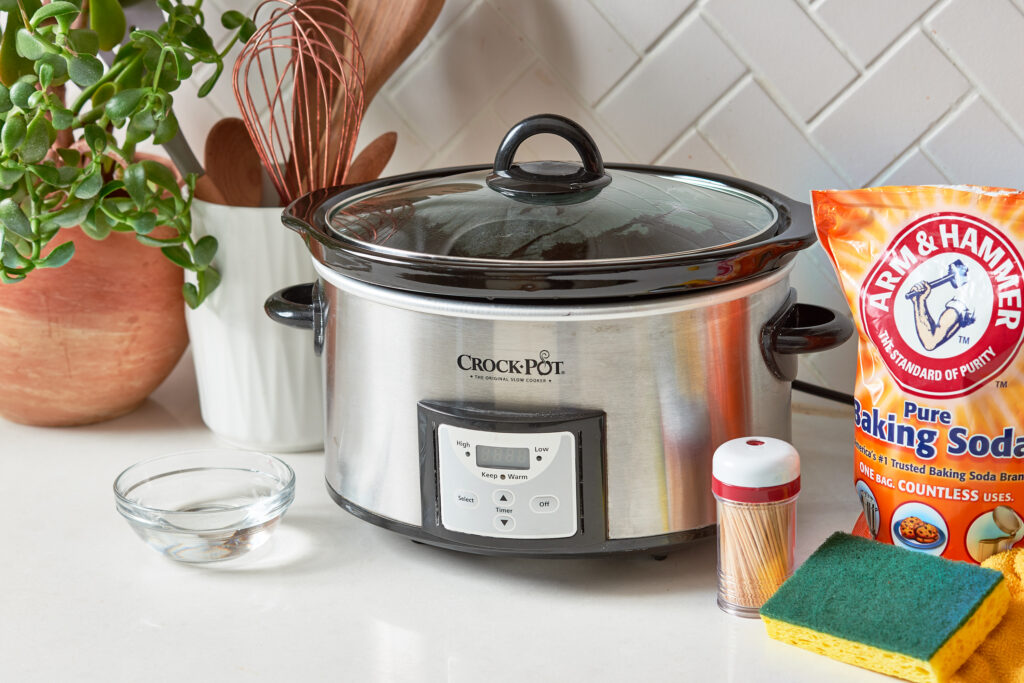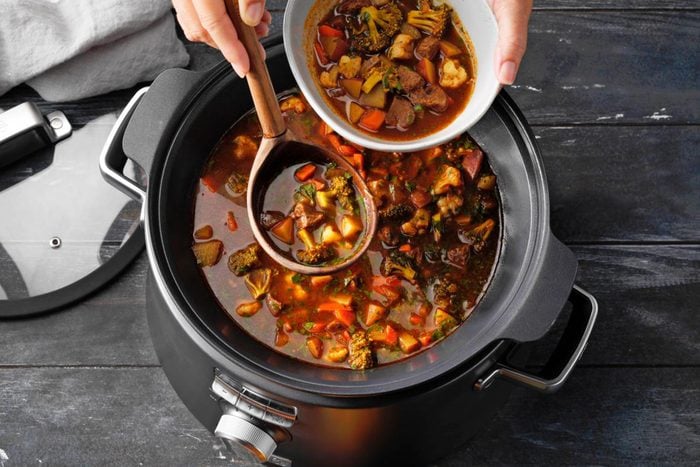
Are you tired of struggling to clean your slow cooker? Fret no more! In this ultimate guide, you will discover effective and hassle-free methods to keep your slow cooker sparkling clean and functioning at its best. From removing stubborn stains to preventing unpleasant odors, we’ve got you covered. Say goodbye to tedious scrubbing and hello to a perfectly maintained slow cooker that will continue to provide you with delicious meals for years to come.

This image is property of storage.googleapis.com.
Cleaning Your Slow Cooker
Gathering the Necessary Supplies
Cleaning your slow cooker is an essential task to ensure its longevity and maintain the quality of the meals you prepare in it. Before you start cleaning, gather the necessary supplies. You will need a soft sponge or cloth, mild dish soap, baking soda, white vinegar, a toothbrush or small cleaning brush for hard-to-reach areas, and paper towels.
Cleaning the Removable Parts
The first step in cleaning your slow cooker is to remove all the removable parts. This typically includes the stoneware insert, lid, and any other detachable components. Rinse these parts with warm water and mild dish soap. Be careful not to use abrasive materials that could scratch the surface.
Removing Stubborn Stains
If you come across stubborn stains on the stoneware insert or the lid, don’t worry. You can use baking soda and white vinegar to tackle them. Make a paste using these two ingredients and apply it to the stains. Let it sit for a few minutes, and then scrub gently with a toothbrush or cleaning brush. Rinse off the paste and repeat the process if necessary. This method is effective in removing even the toughest stains.
Cleaning the Exterior
To clean the exterior of your slow cooker, dampen a soft sponge or cloth with warm water and mild dish soap. Gently wipe down the entire surface, paying attention to any food splatters or spills. If your slow cooker has a stainless steel exterior, you can use a stainless steel cleaner to achieve a polished look. Remember to dry the exterior thoroughly to avoid any water spots.
Taking Care of the Lid
The lid of your slow cooker is prone to collecting dirt, grease, and stains. To clean it effectively, remove any food remnants or debris, and wash it with warm water and mild dish soap. If the lid has a rubber gasket or seal, be sure to clean around it as well. Dry the lid thoroughly before placing it back on the slow cooker.
Cleaning the Heating Base
The heating base of your slow cooker is the part that houses the electrical components. As such, it should never be submerged in water. To clean the heating base, unplug the unit and wipe it down with a damp cloth or sponge. Pay extra attention to any spills or drips that may have accumulated over time. Ensure the base is completely dry before storing or reconnecting it.
Dealing with Lingering Odors
Sometimes, after cooking certain dishes, you may notice lingering odors in your slow cooker. To combat this, create a mixture of equal parts water and white vinegar. Pour this mixture into the stoneware insert and let it sit for a couple of hours. Then, rinse it thoroughly and dry it. This method helps eliminate odors and leaves your slow cooker smelling fresh.
Preventing Bacterial Growth
Bacterial growth can be a concern if not properly addressed. After each use, it is crucial to wash the parts of your slow cooker with warm, soapy water. This helps remove any food residue that could encourage bacterial growth. Additionally, always ensure that the stoneware insert and lid are completely dry before storing them. Moisture can create an environment conducive to bacterial growth, so proper drying is essential.
Storing Your Slow Cooker Properly
When not in use, it is important to store your slow cooker properly to maintain its condition. Keep all the parts together, including the lid, stoneware insert, and any other detachable components. Store them in a cool, dry place to avoid any potential damage. If your slow cooker has a cord, make sure it is neatly wrapped and secured to prevent any tangles or accidents.
Maintaining Your Slow Cooker
Regular Inspections and Maintenance
To ensure the optimal performance of your slow cooker, it’s essential to conduct regular inspections and maintenance. Check for any signs of wear, rust, or damage, both on the exterior and interior components. This will help you address any issues promptly and prevent further damage.
Checking for Damaged Parts
Inspect the stoneware insert, lid, and other removable parts for any cracks or chips. Damaged parts can affect the effectiveness of your slow cooker and even pose safety risks. If you notice any damage, it’s best to replace the affected component to maintain the quality and safety of your meals.
Replacing Worn Out Components
Like any appliance, slow cookers have components that can wear out over time. Components such as the rubber gasket or seal on the lid may need replacing if they become cracked or lose their elasticity. Check the manufacturer’s recommendations for replacement parts and ensure you use genuine replacements.
Calibrating the Temperature
Over time, slow cookers may experience temperature discrepancies, resulting in undercooked or overcooked meals. To calibrate the temperature, you can use an oven-safe thermometer. Place the thermometer in the slow cooker, set it on low, and let it cook for several hours. Check the internal temperature to ensure it reaches the desired range.
Using Liners or Cooking Bags
Using liners or cooking bags can make the cleaning process easier and help prevent food from sticking to the stoneware insert. These liners are generally oven-safe and can be placed inside the insert before adding your ingredients. Keep in mind that liners are optional and not all recipes may be suitable for their use.
Avoiding Abrasive Cleaning Methods
When cleaning your slow cooker, it’s important to avoid abrasive cleaning methods, such as harsh scrub brushes or abrasive cleaners. These can damage the non-stick coating on the stoneware insert and the exterior finish. Stick to gentle cleaning techniques, such as using a soft sponge or cloth, mild dish soap, and non-abrasive cleaning solutions.
Avoiding Submerging the Heating Base
The heating base should never be submerged in water. This could result in electrical damage and pose serious safety risks. To clean the heating base, unplug the unit and wipe it down with a damp cloth or sponge. Never use excessive amounts of water or cleaning solutions that could seep into the electrical components.
Proper Handling and Storage
Proper handling is crucial to maintaining your slow cooker’s condition. Avoid slamming the lid down or forcefully placing the stoneware insert into the heating base, as this can cause cracks or damage. Additionally, when storing your slow cooker, ensure it is protected from any potential impacts or falls that could lead to breakage.
Frequently Asked Questions
Q: Can I wash the stoneware insert in the dishwasher? A: Most slow cookers have stoneware inserts that are dishwasher safe. However, it’s always best to refer to the manufacturer’s instructions for your specific model to ensure safe and proper cleaning.
Q: How often should I clean my slow cooker? A: It is recommended to clean your slow cooker after each use to prevent the buildup of food residues and odors.
Q: Can I use bleach to clean my slow cooker? A: No, bleach is not recommended for cleaning slow cookers. Stick to mild dish soap, baking soda, and white vinegar for effective and safe cleaning.
Troubleshooting Common Issues
If you encounter any issues with your slow cooker, here are some troubleshooting tips:
-
Issue: The slow cooker doesn’t heat up. Solution: Check if the unit is properly plugged in and the outlet is functional. If the problem persists, it may require professional repair.
-
Issue: Uneven cooking or burnt spots. Solution: Ensure the ingredients are evenly distributed in the stoneware insert. Consider stirring them periodically to avoid hot spots.
-
Issue: Slow cooker takes longer than usual to cook. Solution: Check if the lid fits tightly, as a loose seal may prolong cooking time. Also, make sure you’re using the correct temperature setting.
By following these cleaning and maintenance guidelines, you can keep your slow cooker in excellent condition and enjoy delicious meals for years to come. Remember to consult the manufacturer’s instructions for any specific recommendations unique to your slow cooker model. Happy slow cooking!

This image is property of www.tasteofhome.com.





